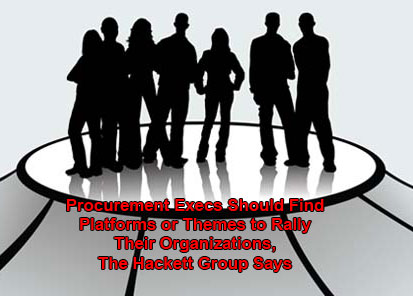 Finding the Right Procurement “Platform” Finding the Right Procurement “Platform”
The consultants say another key factor in gaining better alignment between procurement and overall corporate strategies is to identify company “imperatives” that will provide their group with a platform for adding value to the business.
Though these will vary across individual companies, Mitchell and Sawchuk identify several themes that may serve as rallying themes at many companies:
- Innovation: The pursuit of innovation is at the top of agendas for most company executives – but procurement is often not considered a strong partner in innovation strategies. Even procurement managers don’t see innovation as a top competency – only half as many procurement managers cited innovation as a top 3 priority versus the percentage priorities corporate executives who place it in the top 3., according to a recent Hackett Group study.
Too often, Mitchell and Sawchuk say, procurement executives focus on the quantity of the spend and not the quality – especially the ability of procurement and the supply base to foster innovation early in the product lifecycle.
- Risk Management: Over the past few years, risk management has moved to the top of the corporate agenda in many companies. In an increasingly global and outsourced world, the amount of total risk concentrated in the supply base continues to increase as well.
Procurement managers have an opportunity to play a key role in leading the effort to optimize risk management decisions. Boston Scientific, for example, is one of a growing number of companies that track “revenue at risk” for potential supply failures.
Procurement clearly can play an essential role in reducing risk through both more savvy negotiations with suppliers, as well as leading efforts at greater collaboration.
- Social Responsibility: This category covers a variety of initiatives, including Green/sustainability initiatives, ethical supplier programs, diversity, etc.
While many companies are embracing various social responsibility programs, the number of companies in which the initiatives have truly penetrated operations is much smaller, Mitchell and Sawchuk say.
“CPOs [Chief Procurement Officers] can take a leadership position here, but also harness the power of more advanced suppliers, customers and non-governmental organizations to create a platform for change,” they say.
Procurement continues to move beyond tactical buying skills as the key value the function brings to the company. Those capabilities are increasingly focused on total cost of ownership reduction and, ultimately, innovation and demand management. Asking the right questions and finding the right theme are key to building an organizational operating model that will allow procurement to execute against an increasingly sophisticated and aggressive set of strategies and plans.
Do you think procurement organizations are sometimes too inwardly focused? Do you like the idea of building various “platforms” or themes to rally the procurement team around? What are some other themes besides the three referenced here? Let us know your thoughts at the Feedback button below. |